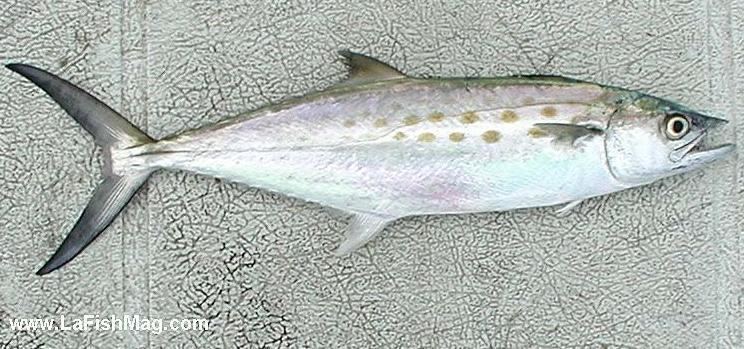Order Perciformes Rank Species | Genus Scomberomorus Higher classification Wahoos | |
 | ||
Similar King mackerel, Wahoos, Spanish mackerel, Crevalle jack, Narrow‑barred Spanish mackerel | ||
The Atlantic Spanish mackerel (Scomberomorus maculatus) is a migratory species of mackerel that swims to the Northern Gulf of Mexico in spring, returns to south Florida in the Eastern Gulf, and to Mexico in the Western Gulf in the fall.
Contents
- Description
- Distributionhabitat
- Migration patterns
- Life history
- Feeding habits
- Fishing gear and methods
- Management
- Nutrition and processing
- Similar species
- References

Description

The fish exhibits a green back; its sides are silvery marked with about three rows of round to elliptical yellow spots. Lateral line gradually curving down from the upper end of the gill cover toward caudal peduncle. The first (spiny) dorsal fin is black at the front. Posterior membranes are white with a black edge. Its single row of cutting edged teeth in each jaw (around sixty-four teeth in all) are large, uniform, closely spaced and flattened from side to side. As with the King mackerel and the Cero mackerel, these teeth look very similar to those of the Bluefish, Pomatomus saltatrix.
Distribution/habitat

Spanish mackerel occur seasonally from the Yucatán peninsula, Mexico, as far north as Cape Cod, Massachusetts. They are a shallow water species, preferring sand bottom in depths of 10 to 40 feet (3 to 12 m), occasionally found as deep as 80 feet (24 m).
Migration patterns

It appears that one Atlantic and one or more Gulf groups of Spanish mackerel occur in Florida waters. With rising water temperatures, the Atlantic group migrates along the Atlantic coast of the United States from Miami Florida, beginning in late February through July reaching as far as southern Cape Cod, Massachusetts, then returning in fall. An Eastern Gulf group moves northward from the Florida Keys during late winter and spring, appearing off the central West Coast of Florida about April 1. Movement continues westward and terminates along the northern Texas coast. During fall, this group migrates back to its wintering grounds in the Keys.
Life history

The Gulf group of Spanish mackerel spawn in batches from May to September off shore of Texas, off the Gulf shore of Florida as early as April in some years. The Atlantic group spawns starting in April off the Carolinas and from late August to late September in the northernmost part of its range. Spanish mackerel mature by age-1 at a fork length (FL) of 14 inches (36 cm). Females live longer and grow to larger sizes than males. Females may live as long as 11 years, growing to 11 pounds (5.0 kg) and 33 inches (84 cm) FL. Males reach about age-6 and 19 inches (48 cm) FL.
Feeding habits

Spanish mackerel are voracious, opportunistic, carnivores. As with other members of the genus, food consists mainly of small fishes with lesser quantities of shrimp and squid. Striped anchovies (Engraulidae) and clupeoids such as menhaden, alewives and thread herring (Opisthonema), are particularly important forage in North Carolina, Florida, Texas, and Veracruz. The percentage of anchovies consumed is higher for juveniles than for adults.
Fishing gear and methods

Spanish mackerel are a highly valued fish throughout their range from North Carolina to Texas. Recreational anglers catch Spanish mackerel from boats while trolling or drifting and from boats, piers, jetties, and beaches by casting spoons and jigs and live-bait fishing. Fast lure retrieves are key to catching these quick fish. Commercial methods are primarily run-around gill netting, and rarely, by trolling lures similar to those used by recreational anglers.
Management

Spanish mackerel are managed in commercial and recreation fisheries with bag limits, size limits, commercial trip limits, and with only seasonal fishing allowed. The management of mackerel has been considered a success because the population used to be in decline, but is now on the rise without overfishing occurring.
Nutrition and processing
Spanish mackerel are primarily marketed fresh or frozen as fillets as commercially caught fish are too small to sell in the form of steaks. Their raw flesh is white. They may be prepared by broiling, frying, baking or, rarely, by smoking.
The Spanish mackerel is also a popular fish among devotees of sushi who prize it for its flavor.
Similar species
Spanish mackerel are similar in appearance to small King mackerel (Scomberomorus cavalla) and Cero mackerel (Scomberomorus regalis). All three are very similar in shape and coloration. They may be distinguished as follows:
The lateral line on Spanish and Cero mackerel slopes gradually from the top edge of the gill to the tail. In contrast that of the king mackerel takes an abrupt drop at mid-body.
The first (spiny) dorsal on Spanish and Cero mackerel has a prominent black patch. The King mackerel has none. As all three species normally keep the first dorsal folded back in a body groove, this difference is not immediately evident.
Spanish mackerel have prominent yellow spots on the flanks at all sizes. In addition to such spots, Cero mackerel have one or more yellow stripes along the centerline. Young King mackerel have similar, but slightly smaller spots; these fade away on individuals weighing over 10 pounds (4.5 kg), but they may still be seen as spots of slightly darker green on the upper back from some angles of view.
Worldwide, there are many members of this genus quite similar to one or another of these three species. In particular, off Mexico, Atlantic Spanish mackerel may be confused with Serra Spanish mackerel (Scomberomorus brasiliensis) which may appear in the same area.
